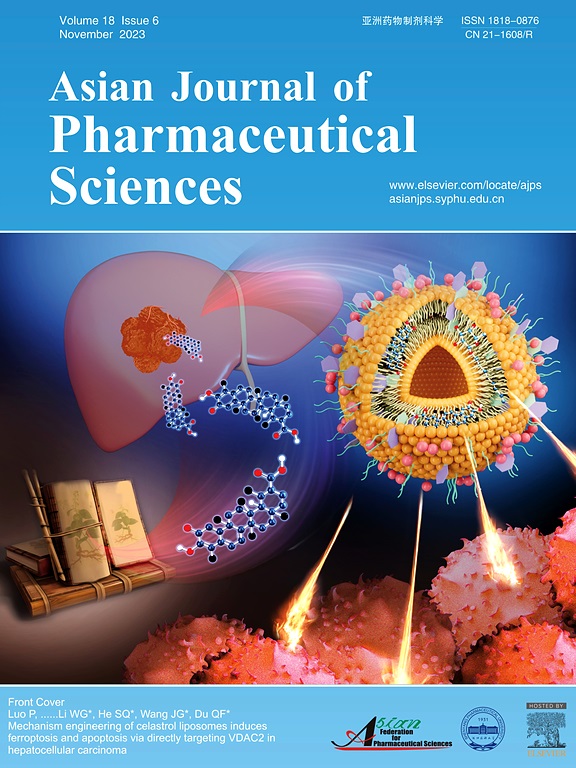Enhancing temozolomide in vivo stability and efficacy through hybrid nanoconjugate approach for improved glioblastoma multiforme treatment
IF 10.7
1区 医学
Q1 PHARMACOLOGY & PHARMACY
引用次数: 0
Abstract
Temozolomide (TMZ) is considered as a standard-of-care DNA alkylating agent for treating glioblastoma multiforme. Despite being a highly potent molecule, TMZ poses several limitations, including short half-life, rapid metabolism, low brain bioavailability and dose-dependent toxicities. Attempts have been made to improve the delivery of TMZ that mainly exhibited nominal therapeutic outcomes. In the current study, we have conjugated TMZ to mPEG-b-P(CB-{g-COOH}) copolymer to obtain mPEG-b-P(CB-{g-COOH; g-TMZn}) that demonstrated improvement in stability and efficacy. Further, a hybrid TMZ nanoconjugate formulation was developed using mPEG-b-P(CB-{g-COOH; g-TMZ40}) and mPEG-polylactic acid (mPEG-PLA) showed an average size of 105.7 nm with narrow PDI of <0.2 and TMZ loading of 21.6 %. Stability was assessed under physiological conditions wherein TMZ was found to be stable with a half-life of ∼194 h compared to 1.8 h for free TMZ. The Hybrid TMZ nanoconjugates showed improved intracellular uptake and reduced IC50 values in C6 and U87MG glioma cells. Furthermore, they exhibited better in vivo therapeutic outcome, i.e., reduced brain weight, hemispherical width ratio and improved survival rate in C6-cell induced orthotropic glioma model in Sprague Dawley rats compared to the free TMZ-treated and positive control animals. Histopathological evaluation also revealed reduced cell infiltration in the lungs and reduced toxicity in major organs. Overall, the hybrid nanoconjugates of TMZ significantly improved its stability and efficacy in the GBM model, thereby opening newer avenues for treatment.

通过混合纳米偶联方法提高替莫唑胺在体内的稳定性和有效性,以改善胶质母细胞瘤多形性治疗
替莫唑胺(TMZ)被认为是治疗多形性胶质母细胞瘤的标准护理DNA烷基化剂。尽管TMZ是一种非常有效的分子,但它也存在一些局限性,包括半衰期短、代谢快、脑生物利用度低和剂量依赖性毒性。已经尝试改善TMZ的递送,主要表现出名义上的治疗结果。在本研究中,我们将TMZ偶联到mPEG-b-P(CB-{g-COOH})共聚物上,得到mPEG-b-P(CB-{g-COOH};g-TMZn}),显示出稳定性和疗效的改善。进一步,利用mPEG-b-P(CB-{g-COOH;g-TMZ40})和mpeg -聚乳酸(mPEG-PLA)的平均尺寸为105.7 nm, PDI窄为<;0.2, TMZ负载为21.6% %。在生理条件下评估稳定性,发现TMZ稳定,半衰期为~ 194 h,而自由TMZ的半衰期为1.8 h。杂交TMZ纳米偶联物在C6和U87MG胶质瘤细胞中表现出改善细胞内摄取和降低IC50值的作用。此外,与游离tmz治疗和阳性对照动物相比,它们在体内表现出更好的治疗效果,即c6细胞诱导的Sprague Dawley大鼠脑重量、半球宽度比和存活率降低。组织病理学评估也显示肺细胞浸润减少,主要器官毒性降低。总的来说,TMZ的杂化纳米偶联物显著提高了其在GBM模型中的稳定性和疗效,从而开辟了新的治疗途径。
本文章由计算机程序翻译,如有差异,请以英文原文为准。
求助全文
约1分钟内获得全文
求助全文
来源期刊

Asian Journal of Pharmaceutical Sciences
Pharmacology, Toxicology and Pharmaceutics-Pharmaceutical Science
CiteScore
18.30
自引率
2.90%
发文量
11
审稿时长
14 days
期刊介绍:
The Asian Journal of Pharmaceutical Sciences (AJPS) serves as the official journal of the Asian Federation for Pharmaceutical Sciences (AFPS). Recognized by the Science Citation Index Expanded (SCIE), AJPS offers a platform for the reporting of advancements, production methodologies, technologies, initiatives, and the practical application of scientific knowledge in the field of pharmaceutics. The journal covers a wide range of topics including but not limited to controlled drug release systems, drug targeting, physical pharmacy, pharmacodynamics, pharmacokinetics, pharmacogenomics, biopharmaceutics, drug and prodrug design, pharmaceutical analysis, drug stability, quality control, pharmaceutical engineering, and material sciences.
 求助内容:
求助内容: 应助结果提醒方式:
应助结果提醒方式:


